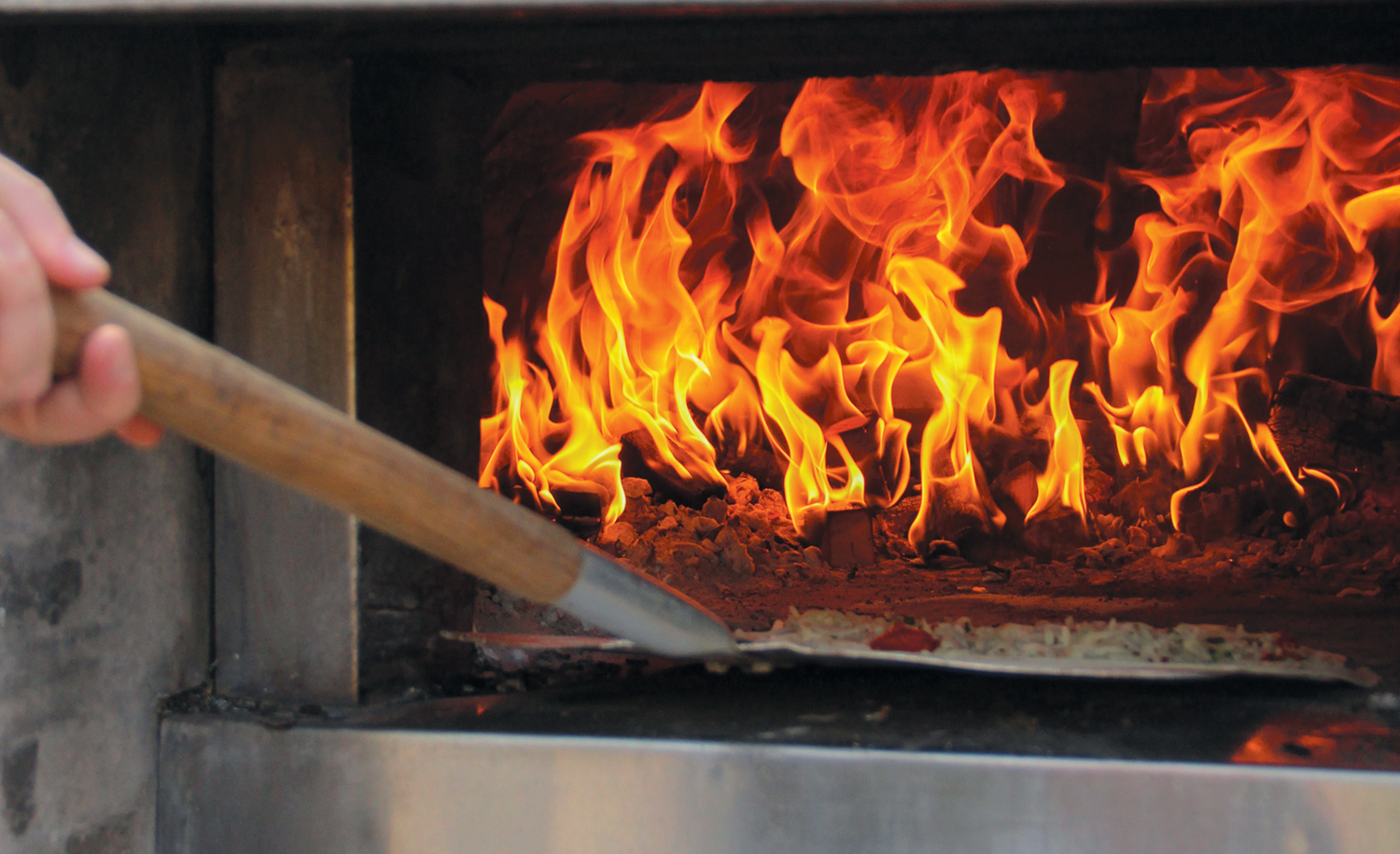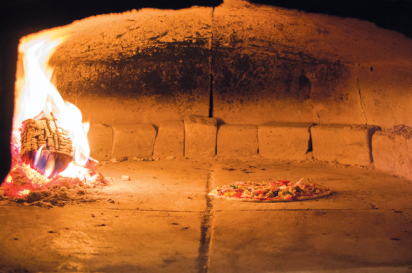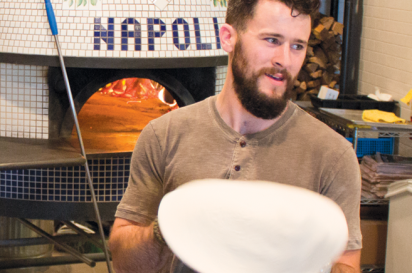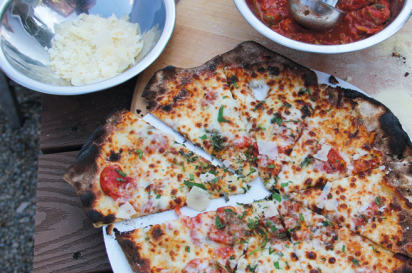Local Chefs Stoked About Wood-Fired Cooking
The whiff of burning logs. The captivating glow of hot embers. The visual geometry of stacked wood and the aesthetic lure of a beautifully tiled Napoli oven. Add to that the spectacle of live-fire cooking, and it’s easy to understand why this ages-old cooking style is such a hot feature at three local restaurants—Figlio, Paulie Gee’s and Snapshots.
A recent article in Restaurant Business reports “new live-fire-focused restaurants are popping up seemingly every day, and menu mentions of ‘wood-fired’ items are up 7% year over year,” according to Technomic’s MenuMonitor.
Ironically, wood-fired cooking is one of the most primitive forms of cooking. Anthropologists’ findings show humans have been cooking over open fires since the Stone Age. The first ovens were fire pits, simple cavities dug in the ground and lined with rocks, which were heated by fire. Next came chamber ovens. Early humble versions were made of clay. More advanced styles of stone, brick and clay evolved from other cultures around the world. Some were vertical ovens like Indian tandoors or Chinese kamados while others were dome-shaped like the Roman ovens. Other milestones brought new fuels and soot-free options like the cast iron oven (1728), gas oven (1826), coal oven (1833) and the electric oven (1890). Today, wood-fired cooking is enjoying a renaissance as customers appreciate the drama of the open kitchen, the hint of smoke and the crackle of food meeting flame.
Newcomer: Paulie Gee’s
One of Columbus’ newest eateries in the wood-fired pizza arena is Paulie Gee’s, an import from Brooklyn, New York. Owner-operator T.J. Gibbs opened his restaurant in the Short North in January 2016 and has built a loyal following for his Neapolitan-style pizzas featuring uber-local twists like the Katzingers 83 Reuben pizza and Ray Ray’s hog pit brisket pizza.
As T.J. demonstrates his cooking technique, he shares that he was introduced to Paulie Gee and his famous Brooklyn pizza restaurant while studying hospitality and business management at The Ohio State University. After graduation, he accepted Paulie’s invitation to spend a year with him in New York learning the business, so he could return to Columbus and open his own Paulie Gee’s restaurant.
T.J. rolls out the dough, adds the soppressata and cheese toppings for a Hellboy pizza then slides it into the oven on the hot stone floor not far from the coals.
“There’s a unique physicality working with such an extremely temperamental oven,” says T.J. as he slides his long-handled peel under the pizza to rotate it a quarter turn. “If you move the pizza eight inches, the temperature can change 100°.”
His investors were concerned there wouldn’t be a talent pool for hiring skilled staff, but T.J. was confident people would respond.
“Each pizza is kinda like a snowflake, and each one is a little bit different. Everyone adds their own twist to it,” he says.
Following a few more quarter turns, T.J. slips the peel under the pizza to raise it for a few seconds to finish melting its cheese beneath the hot dome ceiling. He pulls it out, drizzles it with Mike’s Hot Honey, then slices and serves it.
“After cooking pizzas for long enough you can just tell,” says T.J. as he explains he judges a pizza’s doneness by its weight.
“The key to the bake is in the dough,” he says. “It would be a shame to invest half of the week into a pizza just to drop the ball on the topping table. With our pizza, in this oven, respecting the proportions of each ingredient is everything.”
Pop-up: Snapshots
At Snapshots in Granville, photographer-turned-restaurant-owner Lucas Atwood fires up a portable wood-fired oven on the back patio of his restaurant. On pizza days, he sets up a work station where guests can watch him roll out his signature pizza dough, top it with locally sourced ingredients and cook pies three at a time.
“I got burned out of the photo business and decided to go full time in the restaurant business with my own place that combines my passions for art with food and entertaining,” says Lucas. Nearly four years into his seven-year restaurant tenure, Lucas was gifted a portable hand-built wood-fired oven on wheels.
“The owner couldn’t keep it and knew I would put it to good use,” he says.
Lucas also inherited his fireman father’s interest in fire and the pizza dough recipe he made as cook for “a lot of hungry men and women” at the fire station. His signature dough is filled with herbs and a hint of brown sugar.
Lucas brings plenty of showmanship to his pizza making. Sporting his “bad-ass chef” apron and mohawk hair style, he stands in front of his graffiti-painted oven that serves as a backdrop to his cooking stage. He assembled a make-shift stage of custom wooden pallets atop sticker-covered steel drums. Here, he works from a series of circular wooden cutting boards to roll out dough, chop ingredients and assemble pizzas with plenty of panache.
“I roll out and don’t toss the dough,” he says. “I want to keep it even and get it as thin as possible.”
He prefers smaller pizzas for more even cooking and tops them with a scratch-made sauce of “not as juicy” grape tomatoes, olive oil and shallots. He selects a dryer cheese mix to keep the pizza from getting too greasy.
Lucas says he learned the art of wood-fired cooking through “plenty of trial and error.”
“It’s very temperamental,” he says. “You really have to be on your game.”
Weather can bring added challenges to the task. For instance, humid or rainy days demand more cooking time for the pizzas.
“That’s the challenge of mastering a volatile heat source,” says Lucas. “It requires skill and vigilance.”
Thankfully, Lucas’ efforts are rewarded with a loyal following and plenty of five-star reviews.
“One pastor customer told me ‘You have a very impressive congregation.’ That changed how I saw my job not just about making money but also about reaching out and sharing love.”
Fire Sides Extras:
“To be sure, there are times when it is not practical to cook over a wood-fire—but as I have found over the years, a charcoal fire, a gas grill or even a cast-iron pan on the stove of a home kitchen can serve to create the texture and wonderful slightly burnt taste of open-fire cookery.”—Francis Mallmann
Gas Stove vs. Electric
If you’re of the culinary persuasion, cooking with a gas stove is the way to go. The open flame of a gas stove allows for subtleties in temperature changes, making for better food. It’s as close as you’re going to get in your kitchen to a campfire. Plus, it allows for charring and toasting foods, and flambéing, in a way electric stoves cannot compare.
Roast It Real Good
Winter = Roast. Roasted sweet potatoes with rosemary take on a candy-like quality without forsaking nutritional value. My house gets warm with the oven pumping at 400°, and smells like the forest. And I don’t have to work over the stovetop; roasting is effortless, baking in flavor and packing in the heat to warm me up.
Grilling While It Snows
I have a friend who swears by grilling year-round. With his cigar and cellphone, he stands by the grill in 30° weather to get a good roast on a steak. Compromising nothing just because it’s freezing, he loves the contrast of the hot grill to the cool air. For the outdoor enthusiast, just because it’s snowing doesn’t mean the grilling has to stop.
Woodstove Memories
Ever visit a friend with a woodstove burning when it’s cold outside and notice how you never want to leave? That’s because the radiant heat off a woodstove is kin to the heat off a campfire—intoxicating. Different from a fireplace, woodstoves offer the true hearth experience. Your home carries the life of fire in an energy-efficient way, and some folks even cook on their woodstoves.
- Colleen Leonardi







